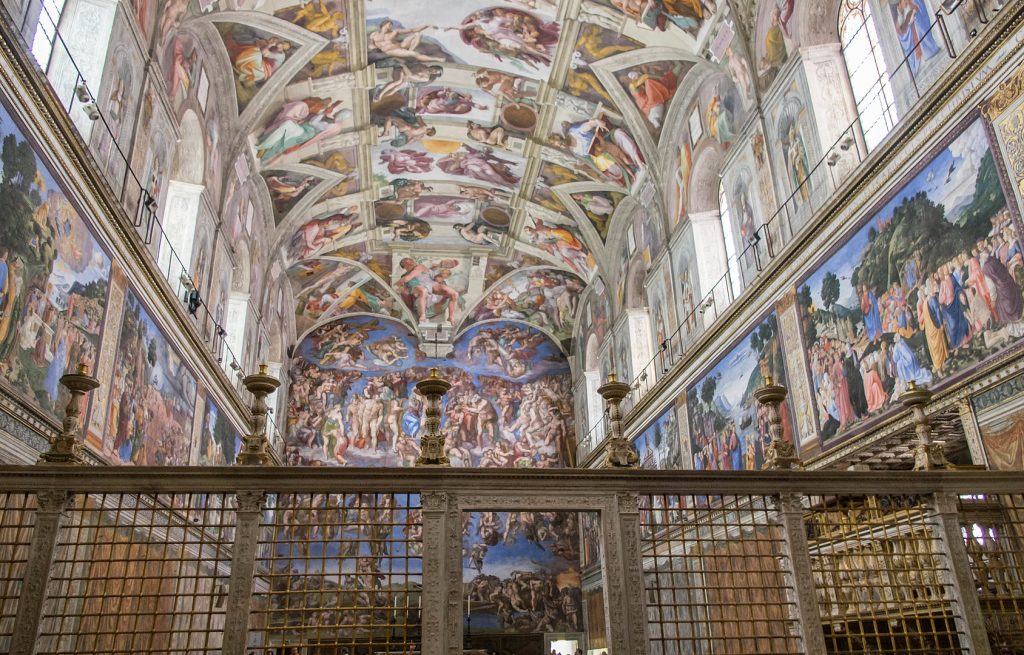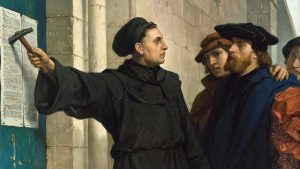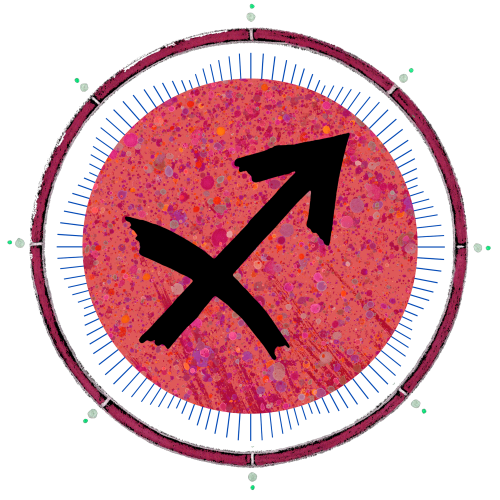
The Jan. 12, 2020 Saturn-Pluto conjunction in Capricorn was exact just a few, short months ago, and we’re watching the results unfold right in front us. To help us more clearly understand the impact of Saturn, (authority and responsibility) joining with Pluto, (death, decay, and transformation) in the sign that represents the institutional structures that gird our lives, it may help to take a look at the last time these two met up in Capricorn.
Saturn and Pluto have a cycle that lasts about 37 years due to the varying length of time that Pluto spends in a sign (e.g. 12 years in Scorpio, but 20 years in Taurus). Consequently, the previous time they met in Capricorn was in 1518, around the middle of the Renaissance. The Renaissance ran from roughly the 14th century to the 17th century, and started in Italy; it coursed it’s way through cities such as Florence, Venice and Milan, surged towards Rome, and breathed new life into that centuries old city that was now the seat of political-religious power throughout much of Western Europe.
It was in this context that Martin Luther, who hailed from Germany, entered the picture and challenged the sale of papal indulgences at the onset of the 1518 Saturn-Pluto conjunction. Luther’s Ninety-five Theses sparked the reformation, and the Catholic Church, being the cornerstone of political power that it was at the time, found itself facing the full might of Saturn and Pluto. But, before we get to the conjunction, let’s look at the time period in a little more detail.
Rome and the Catholic Church Circa 1500
Artists were a form of currency to the rich and powerful of the time and, in 1518, Pope Leo X was one of Europe’s most powerful men. Like the pope’s of the past 40 years before him, Leo led a decadent lifestyle at odds with the authority he claimed, and the faith that he professed.
At the turn of the 16th century, Rome was in the midst of rekindling its former glory as artists assiduously ornamented the city with religious iconography and artwork; Lorenzo de’ Medici, the Florentine patron of the arts and one time de facto ruler of Florence, described Rome as the “meeting place of all the vices.” For what little physical space the papal states took up, they maintained a hold on the souls of Christians throughout Europe despite the papacy’s debauched reputation. Lorenzo’s son, Giovanni, went on to rule Rome from 1513 to 1521 as Pope Leo X and was in power during the conjunction.
As for the rest of the Italian peninsula, the nation of Italy as we know it today wasn’t unified until the late 19th century. Thus, from roughly 1494 to 1559, the Italian Wars raged wherein alliances and double-crosses between the independent Italian city states increasingly involved the rest of Europe, by which time the Renaissance had spread throughout. For instance, in England literature experienced a revival, although Shakespeare wouldn’t be born until near the end of the Renaissance in 1564. And, in Germany printmaking gained in influence.
1518, the year of the Saturn-Pluto conjunction, saw a temporary peace established at the behest of Pope Leo X as the various European nations banded together to defend against the Ottoman Empire. Still, it was an uneasy peace in what was a tempestuous and extravagant time: Michelangelo had finished painting the ceiling of the Sistine chapel and was soon to finish his statue of David; Raphael had completed his four stanze; and, by this time, Leonardo had immigrated to France to live out his final days.

Artists were a form of currency to the rich and powerful of the time and, in 1518, Pope Leo X was one of Europe’s most powerful men. Like the pope’s of the past 40 years before him, Leo led a decadent lifestyle at odds with the authority he claimed, and the faith that he professed. Leonard Shlain’s The Alphabet Versus the Goddess details the impropriety of the popes in this period: Pope Sixtus IV conferred large sums of money and esteemed religious positions to family members who were completely unqualified; Alexander VI, (also known as Rodrigo Borgia), ordered a man’s hand cut off and tongue removed over “a joke told at the pope’s expense.”
Pope Julius II rode at the head of a mercenary army in battle against fellow Christians; and Leo X, the pope at the time of the conjunction, once had a party wherein the meals were served on solid gold dishes that, instead of being washed, were casually thrown out of the window into the Tiber river, (actually there were nets below to catch the plates in order to repeat the stunt at further parties).
A Need for Structural Reform
Through the sale of indulgences; the poor, common folk could atone for their wrongdoings in exchange for coin. You could pay for deceased relatives to get out of purgatory, or, hey, even pay in advance for any future sins you might commit. Pluto in Capricorn: the commodification of sin.
In the face of this complete and utter abuse of power (Pluto) and responsibility (Saturn) on the part of the institutions (Capricorn) responsible for tending to the needs of the common people, citizens cried out for reform to no avail. Instead, the powers that be sought to take even more money from them, but we’ll get to that in a moment…
Any of this sound familiar?
Those in power refused to heed criticism as Shlain points out, “It never seemed to have occurred to Leo that reform was necessary. He believed as did his predecessors, that threats, excommunication, and burning at the stake were the most efficient method of dealing with critics.” Despite the lax attitude religious authorities had begun to take with the arts and philosophy, the consolidation of their power came from the fact that only certain, privileged members of society had permission to access the knowledge needed to secure salvation i.e. to be spared suffering in the afterlife.
And, by this time, those privileged positions were increasingly being filled with clergymen who had no heart for the service they were meant to provide the laity, on account of the corruption at the top. This unmitigated hold on power is what Martin Luther and the Protestant Reformation eventually went on to challenge.
The linchpin, or, to be said another way, what lead to the before-and after moment of Saturn conjunct Pluto, was the sale of papal indulgences. With greed being, essentially, the primary motive of the Church at this point, the ongoing luxuries and excesses required that the pope’s funds be replenished.
One way this was done was through the sale of indulgences; the poor, common folk could atone for their wrongdoings in exchange for coin. You could pay for deceased relatives to get out of purgatory, or, hey, even pay in advance for any future sins you might commit. Pluto in Capricorn: the commodification of sin. When indulgences began to be peddled in Germany, Martin Luther wrote in protest.
As the Reformation gained steamed throughout the 16th century, it’s foundation completely challenged how the Catholic Church consolidated its power: reformers called for the widespread availability of local translations (i.e. not in Latin) of the Scriptures.
Martin Luther Questions the Sale of Indulgences

Luther was born in Eisleben, Germany on November 10th 1483. At his father’s insistence, he was originally going to be a lawyer, but he quickly left that course of study to follow philosophy. During a strong storm on his way back to university he dedicated his life to becoming a monk, in a moment of fear. He was ordained in 1507, and by 1515 he was a provincial vicar, which meant he was responsible for managing eleven different provincial monasteries.
This is the level of influence he carried when on Oct. 31, 1517 he sent a letter opposing the sale of indulgences (apparently it’s in question whether he actually nailed his Theses to the Church door as was commonly taught). Alongside his letter he sent his “Disputation of Martin Luther on the Power and Efficacy of Indulgences,” which we now refer to as his Ninety-five Theses. His influence only grew as the years went on, and his views became harsher, in general, and much more at odds with the Catholic Church.
But initially, Luther didn’t set out to completely challenge the power of the Catholic Church. He didn’t even see his views as diverging from canon. However, in that few month period between Luther drafting his Theses in 1517 and the Saturn-Pluto conjunction in 1518, (and even beyond that) the Catholic Church made the Protestant Reformation all but inevitable due to a reluctance to reform. As the Reformation gained steamed throughout the 16th century, it’s foundation completely challenged how the Catholic Church consolidated its power: reformers called for the widespread availability of local translations (i.e. not in Latin) of the Scriptures.
The Broad Astrology of it All
Where we’re going, today, and what our recent Saturn-Pluto conjunction will mean is still largely up in the air, and dependent on our choices now. The analogues should be clear between the conjunction of 1518 and today’s, but it could still help to explore them further.
So how does all of this fit into Saturn conjunct Pluto in Capricorn?
Immediately prior to the conjunction, a call for change was issued with Martin Luther’s theses at the end of 1517 — a moment of truth. The Catholic Church was an institution with “a deep-rooted corruption” as historian Ludwig Pastor put it, and under the influence of Pluto it was made more apparent; the rot within the system was exaggerated and unavoidable. At the time, it’s authority was nigh unquestionable, à la Saturn, and religion was the bedrock of society in the West — there’s your Capricorn. Yet even at the height of the excesses of the time, the leaders were facing a moment of accountability. But, action wasn’t taken and by the time the conjunction rolled around in January 1518, events where set into motion (which I’ll save for a later discussion) that all but solidified the death of that system and its supremacy.
A full look at the results of the Reformation are beyond the scope of this work, but to suffice it to say that Western society changed irrevocably. There was an indirect backlash against the grandiosity of Rome through iconoclasm, (the rejection and destruction of visual images which was done in stride when the Roman empire converted to Christianity, and which the Renaissance had just worked so hard to restore), and the violent Sack of Rome in 1527; an event that would have been unfathomable before the 1518 conjunction.
Over time, the splintering of Christianity caused its political influence to wane, setting the stage for The Enlightenment, which eventually flowed into the events we’re living today. Standing in our moment, and in light of the previous conjunction in Capricorn, we’re not that far removed from 1518.
Where we’re going, today, and what our recent Saturn-Pluto conjunction will mean is still largely up in the air, and dependent on our choices now. The analogues should be clear between the conjunction of 1518 and today’s, but it could still help to explore them further. Until then, I think it’s safe to say that we live in a monumental time, and it’d be a shame to miss out. So, keep your eyes wide and, as best as you can, have fun!
Your friend,
Spencer Stevens




1 thought on “What Happened at the Last Saturn-Pluto Conjunction in Capricorn? By Spencer Stevens”